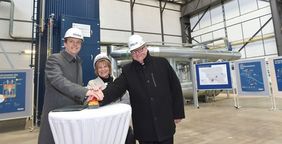
Ministerpräsident Tobias Hans starts up STEAG’s 20 MW electrode boiler
Essen/Völklingen-Fenne. Tobias Hans, Christian Democrat Minister President of the Saarland, has started up an electrode boiler with a capacity of 20 megawatts at the STEAG GmbH power plant site in Völklingen-Fenne. With the electrode boiler, the Essen-based energy company is making a useful contribution to overcoming the challenges of the energy transition in Germany. The electrode boiler rapidly and efficiently converts surplus electricity into storable heat. Heating and mine gas networks have long been coupled at the Völklingen-Fenne site. Now, electricity is also to be linked in. The project is being funded by Germany’s Federal Ministry for Economic Affairs and Energy (BMWi) as part of the DESIGNETZ showcase research program.
Joachim Rumstadt, Chairman of the Board of Management of STEAG GmbH, says: “In this research project, we are moving towards networking the electricity, heat and mine gas sectors more closely and in that way using them more flexibly and intelligently. This is a contribution that has received little attention to date, but is relevant to the success of the energy transition.” The extended energy integration is intended to compensate in future for the weather-related fluctuations that inevitably occur in electricity generation from renewable sources. The use of negative-priced surplus electricity in the heating sector is significantly more cost-effective than all other technical alternatives.
Minister President Tobias Hans pressed the “red button” during a site visit to Völklingen-Fenne and thus officially gave the starting signal for the work on the research project: “This investment makes the Saarland more future-proof as an energy location. It is part of the ‘DESIGNETZ’ showcase project, which was launched on January 1, 2017 and will run for four years. In North Rhine-Westphalia, the Rhineland-Palatinate and the Saarland it illustrates ways in which a future-oriented, safe and efficient energy supply can be used as a practical guideline for the energy transition. The project, which is part of the ‘SINTEG’ funding program of the Federal Ministry for Economic Affairs and Energy, can draw on a project consortium of 46 experienced partners from the energy industry, manufacturing industry, research and development".
The basic technology of the electrode boiler has already proven itself in practice. “What’s new is that an electrode boiler is being tested in conjunction with many other systems,” says Lars Wenning, Project Manager for Electrode Boilers. These include a district heating storage tank, two hard coal fired units with district heating extraction, a mine gas engine CHP unit with district heating extraction, a gas fired boiler, a large-scale battery system and a gas turbine.
Funktionality of electrode boilers
In the electric boiler, water is heated by electricity at a current of more than 1,000 amps. The electric current directly heats the water – at a voltage of over 10,000 volts. For comparison, a standard household power socket in Germany supplies a voltage of 230 volts and a current of up to 16 amps. The electrodes conducting the current are located in an inner, second tank in the boiler, which is completely insulated from the outer wall. Since the heat is generated by the current flow directly in the water, a high thermal output can be generated in a relatively compact device. While high currents and voltages occur inside the electrode boiler, practically nothing can be seen or heard of the operation of the system outside, even at full load.
DESIGNETZ showcase project
Around 95 percent of the plants that generate electricity from renewable energy sources feed their electricity directly into the distribution network. The associated volatility has also increased the demands placed on the distribution network. For this reason, new solutions are needed to ensure that the population will continue to be supplied with electricity safely and reliably in the future. The goal of DESIGNETZ is to develop the necessary framework and new solutions. As one of 47 partners from business, industry and research, STEAG contributes its great expertise from over 80 years of successful activity in the energy industry. In the Saarland, this includes an electrode boiler with a capacity of 20 megawatts and a district heating storage tank. DESIGNETZ is one of a total of five projects in the funding program “Schaufenster intelligente Energie - Digitale Agenda für die Energiewende” (SINTEG), which is funded by the BMWi. In this funding program, transferable model solutions for a safe, cost-effective and environmentally compatible energy supply with up to 100 percent electricity generation from renewable sources are developed and demonstrated in large “showcase regions”
Negative electricity prices
Negative electricity prices arise when the supply of electricity is greater than the demand. With the energy transition, more and more electricity is being produced from volatile renewable energy sources. The amount of electricity produced from wind or the sun cannot, however, be predicted precisely. When the wind is blowing strongly, as in a storm, a large amount of electricity is suddenly produced. If, at the same time, only a little electricity is consumed, the high level of supply coincides with low demand. This leads to negative electricity prices. Under these circumstances, a purchaser is paid for the amount of electricity he buys, whereas a generator has to pay extra when he sells his electricity.
